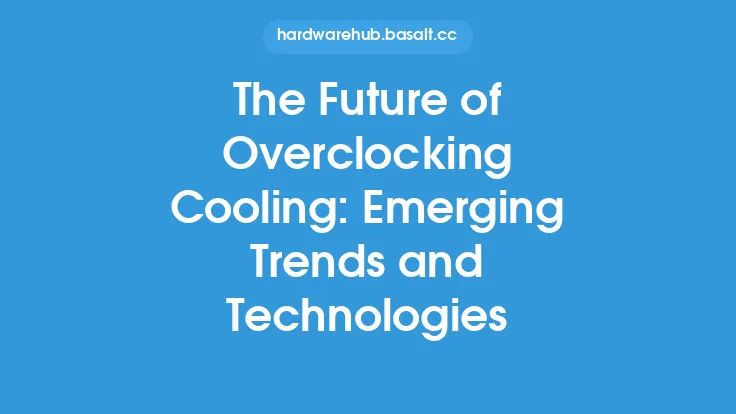Passive cooling techniques have become increasingly popular in recent years, particularly among those who value a quiet computing environment. Unlike active cooling methods, which rely on fans to dissipate heat, passive cooling techniques utilize natural convection, radiation, and conduction to regulate temperature. This approach not only reduces noise levels but also increases the overall reliability and lifespan of the system. In this article, we will delve into the world of passive cooling techniques, exploring the various methods and technologies that enable reduced noise levels in computing systems.
Introduction to Passive Cooling
Passive cooling techniques are designed to minimize the reliance on mechanical components, such as fans, which are a primary source of noise in computing systems. By leveraging the natural properties of materials and the environment, passive cooling systems can effectively dissipate heat without generating significant noise. This approach is particularly useful in applications where silence is paramount, such as in home theaters, audio recording studios, and other noise-sensitive environments. Passive cooling techniques can be broadly categorized into three main types: natural convection, radiation, and conduction.
Natural Convection Cooling
Natural convection cooling is a passive cooling technique that relies on the natural movement of air to dissipate heat. This method is based on the principle that warm air rises, creating a circulation of air that draws cooler air into the system. Natural convection cooling is often used in conjunction with heat sinks, which are designed to maximize the surface area exposed to the surrounding air. By increasing the surface area, heat sinks can more efficiently transfer heat to the surrounding air, allowing the system to cool more effectively. Natural convection cooling is a simple and cost-effective method, but it can be limited by the ambient temperature and air pressure.
Radiation Cooling
Radiation cooling is another passive cooling technique that involves the transfer of heat through electromagnetic waves. All objects emit thermal radiation, which can be used to dissipate heat from a system. Radiation cooling is often used in conjunction with specialized materials, such as radiative coatings, which are designed to enhance the emission of thermal radiation. This method is particularly useful in applications where the system is operating in a vacuum or in a environment with limited air movement. Radiation cooling is a highly effective method, but it can be limited by the temperature difference between the system and the surrounding environment.
Conduction Cooling
Conduction cooling is a passive cooling technique that involves the transfer of heat through direct contact between objects. This method is often used in conjunction with heat sinks, which are designed to maximize the surface area in contact with the surrounding material. Conduction cooling is particularly useful in applications where the system is in direct contact with a heat sink or a cooling surface. This method is highly effective, but it can be limited by the thermal conductivity of the materials involved.
Heat Sink Design
Heat sink design plays a critical role in passive cooling techniques. A well-designed heat sink can significantly enhance the cooling performance of a system, while a poorly designed heat sink can limit the effectiveness of the cooling method. Heat sinks are typically designed to maximize the surface area exposed to the surrounding air, while also providing a high thermal conductivity path for heat transfer. The design of a heat sink depends on the specific application and the cooling method used. For example, a heat sink designed for natural convection cooling may have a different design than one designed for radiation cooling.
Materials Used in Passive Cooling
The materials used in passive cooling systems play a critical role in their effectiveness. Materials with high thermal conductivity, such as copper and aluminum, are often used in heat sinks and other cooling components. These materials are able to efficiently transfer heat, allowing the system to cool more effectively. Other materials, such as radiative coatings, are used to enhance the emission of thermal radiation, allowing the system to cool through radiation. The choice of material depends on the specific application and the cooling method used.
Applications of Passive Cooling
Passive cooling techniques have a wide range of applications, from consumer electronics to industrial systems. In consumer electronics, passive cooling is often used in devices such as laptops, tablets, and smartphones, where noise levels are a concern. In industrial systems, passive cooling is used in applications such as telecommunications equipment, medical devices, and aerospace systems, where reliability and lifespan are critical. Passive cooling techniques are also used in emerging technologies, such as electric vehicles and renewable energy systems, where noise levels and reliability are important considerations.
Advantages and Limitations
Passive cooling techniques have several advantages, including reduced noise levels, increased reliability, and lower maintenance costs. However, they also have some limitations, such as limited cooling capacity and dependence on ambient temperature and air pressure. Passive cooling techniques are often used in conjunction with active cooling methods, such as fans, to provide a hybrid cooling solution. This approach allows the system to take advantage of the benefits of both passive and active cooling methods, while minimizing the limitations of each.
Conclusion
Passive cooling techniques offer a highly effective method for reducing noise levels in computing systems. By leveraging natural convection, radiation, and conduction, these techniques can provide a reliable and efficient cooling solution. The design of heat sinks and the choice of materials play a critical role in the effectiveness of passive cooling systems. While passive cooling techniques have some limitations, they offer a wide range of benefits, including reduced noise levels, increased reliability, and lower maintenance costs. As the demand for silent computing systems continues to grow, passive cooling techniques will play an increasingly important role in the development of cooling systems.





